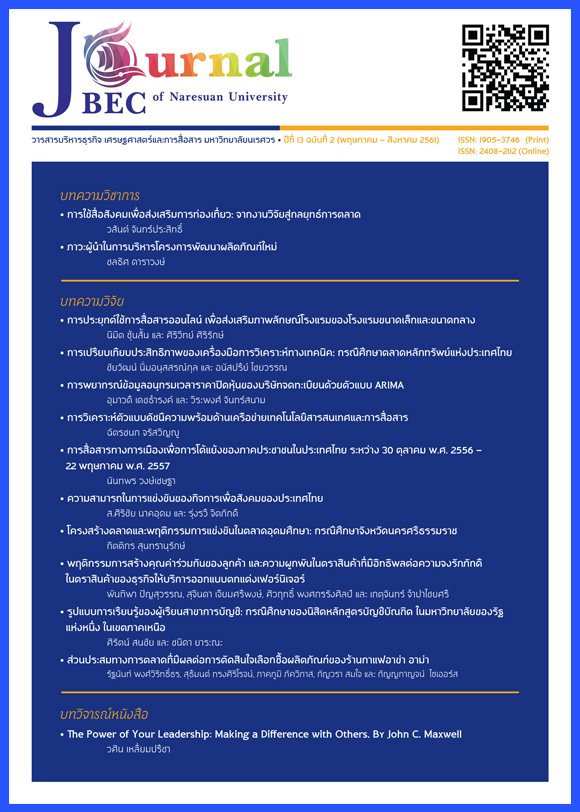รูปแบบการเรียนรู้ของผู้เรียนสาขาการบัญชี: กรณีศึกษาของนิสิตหลักสูตรบัญชีบัณฑิตในมหาวิทยาลัยของรัฐแห่งหนึ่ง ในเขตภาคเหนือ [Learning Style of Students: A Case Study of Bachelor’s Degree Students in Accounting of a State University in Northern Thailand]
Main Article Content
บทคัดย่อ
การวิจัยครั้งนี้มีวัตถุประสงค์เพื่อศึกษารูปแบบการเรียนรู้ของผู้เรียนสาขาการบัญชี หลักสูตรบัญชีบัณฑิต และศึกษาเปรียบเทียบรูปแบบการเรียนรู้ของนิสิตสาขาการบัญชีจำแนกตาม เพศ ระดับชั้นปี และผลการเรียนเฉลี่ยสะสมล่าสุดของผู้เรียน รวมทั้งเสนอแนะแนวทางในการพัฒนาและปรับปรุงการเรียนการสอนหลักสูตรปริญญาตรี บัญชีบัณฑิตให้เหมาะสมกับรูปแบบการเรียนรู้ของนิสิต ผลการศึกษาพบว่า นิสิตหลักสูตรบัญชีบัณฑิต ส่วนใหญ่มีรูปแบบการเรียนรู้แบบร่วมมือ เมื่อเปรียบเทียบลักษณะประชากรศาสตร์กับรูปแบบการเรียนรู้แต่ละแบบพบว่า นิสิตที่มีเพศ และชั้นปีที่ศึกษาแตกต่างกันจะมีรูปแบบการเรียนรู้แบบอิสระ แบบหลีกเลี่ยง และแบบแข่งขันที่แตกต่างกัน ในขณะที่นิสิตที่มีผลการเรียนเฉลี่ยสะสมแตกต่างกัน มีรูปแบบการเรียนรู้แบบหลีกเลี่ยงแตกต่างกันอย่างมีนัยสำคัญทางสถิติเช่นกัน นอกจากนี้กลุ่มตัวอย่างได้เสนอแนะแนวทางในการพัฒนาและปรับปรุงการเรียนการสอนหลักสูตรปริญญาตรีบัญชีบัณฑิตว่าควรจัดให้มีการเรียนรู้แบบกลุ่ม โดยผู้สอนมีบทบาทเป็นผู้ที่ชี้แนะคำตอบของปัญหา รวมทั้งใช้กิจกรรมหลากหลายเพื่อสร้างบรรยากาศที่ดีในการเรียนรู้ ผลการวิจัยนี้สามารถทำให้เข้าใจรูปแบบการเรียนรู้ของผู้เรียนสาขาการบัญชีในปัจจุบันและนำไปสู่การพัฒนา ปรับปรุงหลักสูตรบัญชีบัณฑิตเพื่อเตรียมความพร้อมของผู้เรียนสาขาการบัญชีสู่ตลาดแรงงานต่อไป
Article Details
References
2. Corbin, A. (2017). Assessing differences in learning styles: Age, gender and academic performance at the tertiary level in the Caribbean. Caribbean Teaching Scholar, 7(April 2017), 67-91.
3. Division of Acedemic Affairs Naresuan University. (2017). Statistics on number of students at Naresuan University, academic year 2017. Retrieved October 30, 2017, from http://www.reg2.nu.ac.th/publish//studentstat_DL/2560/สถิตินิสิตประจำปีการศึกษา_2560[24-10-2560].pdf
4. Duff, A. (2004). The role of cognitive learning styles in accounting education: Developing learning competencies. Journal of Accounting Education, 22(1), 29-52.
5. Federation of Accounting Professions under the Royal Patronage of His Majesty the King. (2017). The international education standard for accounting professionals no. 4: Values, ethics and professional attitudes. Retrieved November 18, 2017, from http://www.fap.or.th/upload/9414/TmPrSTfYeb.pdf
6. Ford, J. H., Robinson, J. M. and Wise, M. E. (2016). Adaptation of the Grasha Riechman student learning style survey and teaching style inventory to assess individual teaching and learning styles in a quality improvement collaborative. BMC Medical Education, 16(252), 1-13.
7. Grasha, A. F. (1996). Teaching with style: A practical guide to enhance learning by understanding learning and teaching style. Pittsburgh: Alliance publishers.
8. Hall, M., Ramsay, A. and Raven, J. (2004). Changing the learning environment to promote deep learning approaches in first-year accounting students. Accounting Education, 13(4), 489-505.
9. Kolb, D. A. (1984). Experiential learning: Experience as the source of learning development. New Jersey: PrenticeHall Inc.
10. McChlerya, S. and Visserb, S. (2009). A comparative analysis of the learning styles of accounting students in the United Kingdom and South Africa. Research in Post-Compulsory Education, 14(3), 299-315.
11. Mookjang, R. (2016). Book review: Enjoy learning in 21 century. Journal of Business, Economics and Communications, 11(1), 190-191.
12. Nakhasaenee, S. (2014). The learning styles of students, Faculty of Liberal Arts, Rajamangala University of Technology Rattanakosin. Rajabhat Chiangmai Research Journal, 15(1), 74-84.
13. Nongnut, T. (2013). The effect of problem-based learning on the architectural conceptual design development for the students of Advance Architectural Design II (ARC417). In Research for Instructional Development (pp. 1-49). Bangkok: Sripatum University.
14. Novin, A. M., Arjomand, L. H. and Jourdan, L. (2003). An investigation into the preferred learning styles of accounting, management, marketing and general business majors. Teaching and Learning, 18(1), 24-31.
15. O’Leary, C. and Stewart, J. (2013). The interaction of learning styles and teaching methodologies in accounting ethical instruction. Journal of Business Ethics, 113(2), 225-241.
16. Polat, Y., Peker, A. A., Ozpeynirci, R. and Duman, H. (2015). The effect of learning styles of accounting education students on their performance: A field study. Procedia - Social and Behavioral Sciences, 174(February 2015), 1841-1848.
17. Ponpruksa, R. (2009). Learning achievement in personal income tax calculation by using teamwork exercises. In Action research in a classroom (pp.1-19). Bangkok: Faculty of Management Sciences, Suan Dusit Rajabhat University.
18. Thaveesin, S., Pattrakorn, N. and Vicheanpant, T. (2002). The learning styles of undergraduate engineering students in Bangkok and surrounding areas. KMUTT Research and Development Journal, 25(4), 335-345.
19. Yarana, C. (2018). The development of critical thinking skills for accounting students: A case study of a seminar in the taxation module. The Golden Teak: Humanity and Social Science Journal (GTHJ), 24(1), 17-31.

